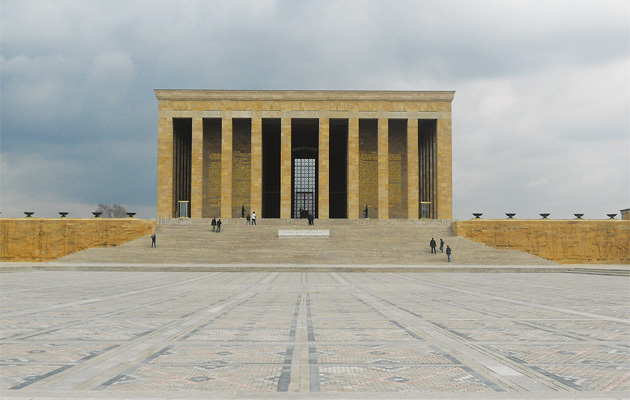|
Atatürk’s tomb was completed nine years after his death |
||
|
A historian’s guide to mausoleums shows that you can’t always judge a tomb by the statesman or dictator lying inside, says Owen Hatherley Ancient historian Gwendolyn Leick tells us that it was a visit to the mausoleum of Kemal Atatürk that made her interested in the tombs of 20th century figures. She was there out of happenstance – she was married to a Turkish son of an army officer – and was obviously not expecting much. Yet, she writes: “I was unaccountably moved by the experience … although at the time I knew very little about Atatürk, the tomb and the whole setting at the mausoleum triggered an emotional response, even a feeling of reverence, in me.” This book tries to answer why she had this response. Visiting a remarkable amount of (mostly, if not exclusively) dictators’ resting places worldwide, she photographs and describes them and the careers of the bodies they contain. It sounds morbid, but isn’t – the result is fascinating, funny and ingenuous. In its seriousness and lack of moral judgement Tombs of the Great Leaders is an antidote to the well established “dictators’ homes” genre. The “Wow, look at Saddam’s rug!” element can, at best, have the effect of ridiculing those who would punish anyone laughing at them; it also asks the reader to ridicule parvenu rulers, usually in the second or third worlds, leaving the tastes of Western, democratic leaders curiously unexplored. Leick doesn’t explore the private aesthetic worlds of her subjects, but their public face: the way in which they wanted to be remembered. After some scene-setting in antiquity, the story begins in 1924, with the embalming of Lenin and his placement in the first of a series of three tombs – the last, in 1930, was designed by Alexey Shchusev as a masterpiece of neo-Sumerian mock-sacral architecture that would set the stripped-classical tone for others that would follow in the communist world. Post-war decolonisation opened up more avenues for the tomb, with several increasingly original designs from Bangladesh to Congo. Most of the leaders whose resting places are profiled here did not want to be entombed. Lenin would have found his body being turned into a place of pilgrimage outrageous, as did his family; Mao and Ho Chi Minh explicitly left wishes that they be buried unassumingly, rather than in the temple-like edifices their remains occupy today. In the cases of Atatürk, Nkrumah or Jinnah, the tombs here were built long after the leaders’ death. Only the vainest of leaders, such as Mussolini, Chiang Kai-Shek and Franco, made plans for their own entombment. At first, the results follow a pattern, usually a rationalised form of the local vernacular, made stark and stiff, as with Jinnah’s great dome or Sun Yat-Sen’s modernised temple. Materials are always opulent and expensive, with a lot of polished marble in evidence. Their role as emblems of state, and often of state creation, often precludes ambiguity. Leick always writes about the effect each building has on her – which is after all the point, with this extreme architecture parlante. At Ho Chi Minh’s tomb, she is repulsed by the banal exterior, designed by a Soviet architect, but finds the complexity and delicacy of the interior, designed by Vietnamese architects, so affecting that she bursts into tears. There’s no hierarchy here, and as the book goes on order becomes chaos. Ayatollah Khomeini’s tomb is dull kitsch, Kim Il-Sung’s is ruthlessly choreographed, Ziaur Rahman’s is open and high-tech, and Yasser Arafat’s temporary tomb is a harsh essay in minimalism. At the end, Leick finds the dictatorial tomb alive and well. She travels to some fabulous examples in Africa, from the socialist-modernist space rocket under which MPLA leader Agostinho Neto rests in Luanda, Angola, to the tense, brutalism-in-marble forms of Nkrumah’s tomb in Accra, to Laurent-Desire Kabila’s ludicrous tomb in Kinshasa, where great bulbous fists hold up a wonky tent. In this proliferation she finds the future of the mausoleum: furiously eclectic and barely recognisable as “sacral” architecture any more. |
Words Owen Hatherley
Tombs of the Great Leaders: a contemporary guide by Gwendolyn Leick
Image: |
|
|
||




















